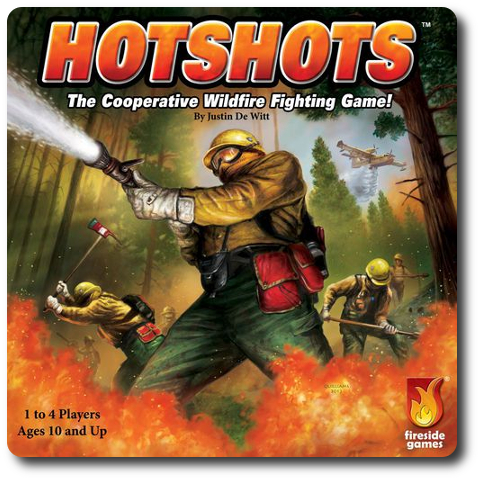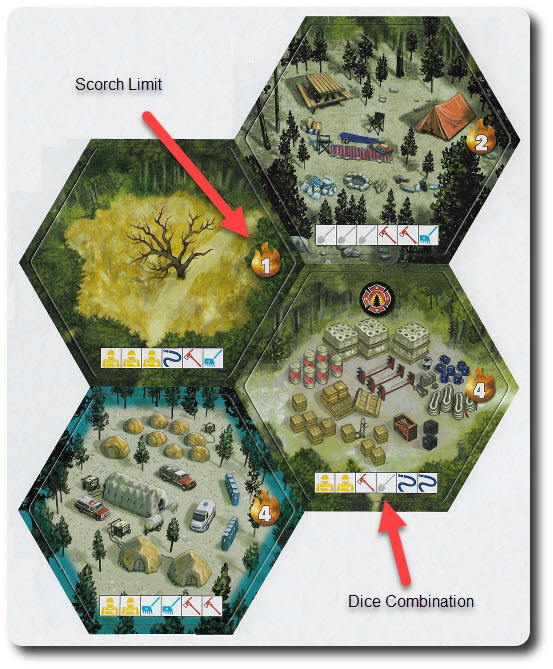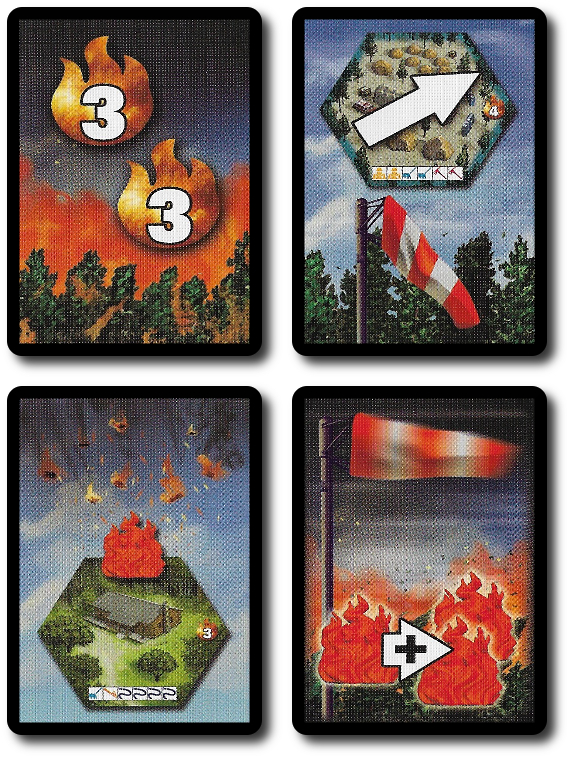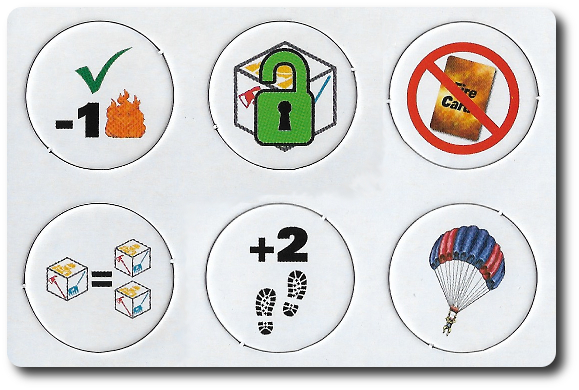
The Basics:
- For ages 8 and up (publisher suggests 10+)
- For 1 to 4 players
- Variable game play length
Geek Skills:
- Active Listening & Communication
- Counting & Math
- Logical & Critical Decision Making
- Strategy & Tactics
- Risk vs. Reward
- Cooperative & Team Play
- Hand/Resource Management
- Worker Placement & Area Control
Learning Curve:
- Child – Easy
- Adult – Easy
Theme & Narrative:
- Fight the forest fires as a team
Endorsements:
- Gamer Geek approved!
- Parent Geek approved!
- Child Geek approved!
Overview
Pulitzer Prize–winning American journalist, Ernie Pyle, said “The closest fires were near enough for us to hear the crackling flames and the yells of firemen. Little fires grew into big ones even as we watched. Big ones died down under the firemen’s valor only to break out again later.” The bravery of the men and women who volunteer to fight the fires that rage in the wilderness cannot be overstated, nor the dangers of doing so. Many of us will never be given (or want) the opportunity to try. In this game, you can test your resolve, your team work, and luck to see if you can put the fires out before it’s too late.
Hotshots, designed by Justin De Witt and published by Fireside Games, is comprised of 4 Crew cards, 25 Flame tokens, 15 Firebreak tokens, 16 Reward tokens, 29 Fire cards, 19 Terrain tiles, 4 Firefighter tokens (with accompanying stands), 3 Vehicle tokens, 6 Firefighter dice, and 1 Wind marker (with a stand). The component quality is excellent. The cards are as thick and as durable as your standard playing card and the cardboard components and dice are very sturdy. Extra points to the game designers for providing Flame tokens that are made of plastic and really look like flames. Artist Víctor Pérez Corbella provides realistic illustrations of the brave men and women who fight to contain the blaze, further strengthening the game’s thematic theme and narrative.
Where There’s Smoke…
To set up the game, first take the Terrain tiles, shuffle them, and then place them (face-up) in the middle of the play area. Players are welcome to create their own layout, but the rule book provides suggestions on initial first-time play and possible other configurations. When placing the tiles, all of them should be orientated the same direction. At minimum, each tile should be touching at least one other tile.

Second, place the Firebreak and Flame tokens off to one side of the game playing area and within easy reach of all the players. You’ll be using these components a lot.
Third, place the Reward tokens off to another side of the game playing area and within easy reach of the players. Shuffle and place face-down. Leave room for a discard pile, as well.
Fourth, place the three Vehicle tokens face-up on the “Air Attack Base” Terrain tile and the Wind marker on the “Fire Camp” Terrain tile. Orientate the Wind marker so it’s facing the “top” of the Terrain tile. In this case, the “top” is based on how you placed the Terrain tiles. The “bottom” of each Terrain tile is considered the portion where the dice combination symbols are shown.
Fifth, take the Fire cards and find the six “Change Wind Direction” Fire cards, setting them aside. Shuffle the remaining cards and divide into two equal piles. Into each of these two piles, shuffle in three “Change Wind Direction” Fire cards, making sure each pile is shuffled separately. Then take one of the two piles and place it on top of the other. This is the Fire draw deck for the duration of the game. Place it face-down next to the game play area.
Sixth, place one or more Flame tokens on each Terrain tile that has a Fire icon. The number of Fire tokens a Terrain tile receives is two less than the Terrain tile’s scorch limit. For example, a Terrain tile with a scorch limit of three would receive one Flame token.
Seventh, shuffle the Crew cards and deal one to each player or have each player select the Crew card of their choice. Place any remaining Crew cards not used back in the game box. Selected Crew cards are placed in front of the owning player and visible for all to see. Each player should find the matching Firefighter token and place it on the “Fire Camp” Terrain tile (the same tile where the Wind marker is currently located). Crew cards have two different sides. One lists a special ability that can be used during the game. Make sure this side is face-up.
That’s it for game set up. Decide who will be the first player and begin!
…There’s A Hell of a Lot of Fire!
Hotshots is played in turns with no set number of turns per game. Hotshots is a cooperative game, meaning that the players are in direct competition with the game itself, not each other. It’s highly recommended that players discuss strategy and tactics openly, but should stop well short of playing the game for others. A typical game turn is summarized here.
Step One: Move!
A player can move their Firefighter token up to two Terrain tiles by default, but only if they want to. There are, of course, rules that dictate how a player moves.
- Players can move to and through any Terrain tile (this includes Terrain tiles that have been scorched and through Firebreaks) with the exception of the “Lake” Terrain tile
- Players must stop their movement if they enter a Terrain tile that has one or more Flame tokens, but they can easily move from these Terrain tiles on their next turn without being stopped
- Entering or leaving a “Rocky” Terrain tile requires the player to use all of their movement
- There is no limit to the number of Firefighter tokens that can occupy a Terrain tile at a single time
Step Two: Fight!
Depending on what Terrain tile the player ends their movement on and the tile’s current conditions, there are several actions the player can take.
If the Terrain tile has any Flame tokens on it or none at all, the player can attempt to fight the fire by rolling the Firefighting dice. The player takes all of the available dice and rolls them. The goal is to match as many symbols found on the Terrain tile as possible, as noted by the dice combination. The symbols represent the tools and equipment the player needs to use to fight the fire in that specific terrain. The dice rolls do not need to match the order in which the symbols are shown and the player can roll as many times as they like as long as they always set aside and “lock” one of the matching dice.
The outcome of the roll is dependent on the number of dice values that match the Terrain tile tokens. Players are encouraged to take the actions available to them, but are welcome to only do what they like.
- Match Three: Place a Firebreak token on any side of the Terrain tile that is adjacent to another Terrain tile. Firebreaks help reduce the odds of fire spreading due to the wind or a nearby Terrain tile being scorched. Firebreaks cannot be placed against a Terrain tile that has been previously scorched.
- Match Four: Remove one Flame token from the Terrain tile.
- Match Five: Remove two Flame tokens from the Terrain tile and then choose to either place one Firebreak or randomly draw one Reward token.
- Match Six: Remove three Flame tokens from the Terrain tile, place one Firebreak, and randomly draw one Reward token.
Step Three: Fire!
The player draws one Fire card and resolves it. Fire cards are always drawn if there is at least one Flame token in play. Since Hotshots is a cooperative game, the player who drew the card should share it with the other players and discuss how best to resolve it.
Fire cards determine how the fire spreads. There are many different Fire cards in the game that will cause trouble. Based on the card, a single fire can start and grow or multiple fires can expand. Wind is also a factor, with a light breeze to a strong gust blowing the fire into new Terrain. The direction in which the flames spread due to wind is based on the current position of the Wind marker.
Once the Fire card is resolved, it’s discarded.

Radio for Support
Each player has a Crew card that has a special ability. These can be used at anytime during the game when it’s possible to do so. Abilities are tied to certain Terrain tiles, meaning that if a specific Terrain tile is scorched, it might mean a player loses their Firefighter’s special ability for the duration of the game. If this does happen, the Crew card is flipped over and the listed ability is no longer shown.

Reward tokens are earned by fighting fires. Reward tokens can be used once to provide a special bonus and each player can have a maximum of three Reward tokens collected at a time. Reward tokens can either provide a temporary seventh die value, change the number of values on a die, reduce fire, add movement, and even give a player another turn. Reward tokens can be shared, with one player taking no more than one Reward token from another player who also has a Firefighter token in the same Terrain tile.

Players also have access to vehicles in the game. Vehicle tokens provide the player with a one-time bonus. The “Air Tanker” drops water on multiple locations, the “Helicopter” targets fires on a specific Terrain tile with precise water drops, and the “Brush Rig” can create Firebreaks.
The greatest support tool available to the player, however, are the other players. Hotshots is as much about teamwork as it’s about risk management. Support is provided to a player who has one or more Firefighters on the same Terrain tile. Support reduces the odds of a Terrain tile blowing up due to not matching dice to the dice combination symbols. Certain Terrain can also provide support, as can Reward tokens.
The Fire Rages
If a player is unable to match at least one of the Terrain tile dice combination symbols after rolling, not only are they not able to fight the fire, but the fire gets worse! A new Flame token is added to the Terrain tile as a result.
If a Terrain tile contains a number of Flame tokens that equals or exceeds the Scorch limit, the terrain in that tile is considered “scorched”, meaning it’s turned to ash. This can happen due to the players not properly fighting a fire, but a Terrain tile can also become out of control due to the results of a Fire card. Several steps are taken to resolve the scorched terrain. None of which is good news for the players.
- Remove all Fire and Firefighter tokens from the Terrain tile, placing the Flame tokens back in the pile and setting aside the Firefighter tokens.
- Flip the Terrain tile over to its scorched side. This side of the Terrain tile looks like a blacked and burned area.
- Add one Flame token to an adjacent Terrain tile with the lowest Scorch limit value that is not blocked by a Firebreak and has the fewest Flame tokens (thus breaking any ties).
This, as you can imagine, can cause adjacent Terrain tiles to be scorched, as well. If such is the case, each Terrain tile is resolved separately. It’s also possible that a nearby Terrain tile is the unlucky recipient of multiple Flame tokens due to adjacent Terrain tiles becoming scorched. Them’s the breaks, kids.
Replace any removed Firefighter tokens to the newly scorched Terrain tile. Any player with a Firefight token in the scorched area must now discard one Reward token. One die is also lost and removed temporarily from the game for each Firefighter caught in the blaze. Removed dice can be returned if the player ends their turn on the “Fire Camp” Terrain tile.
But wait! It gets worse! Some Terrain tiles have special effects that are resolved when they become scorched. For example, if the “Mobile Repair Shop” is scorched, any player who is acting as the “Sawyer” Firefighter loses their ability and the “Propane Tank” Terrain tile figuratively explodes, adding Flame tokens to all surrounding Terrain tiles. There is even a tile that can cause the game to immediately end and the players to lose if it becomes scorched.
The only positive news is that scorched Terrain tiles cannot have new Flame tokens added to them. They become permanent Firebreaks.
To Hell and Back
The game continues as described above until all the Flame tokens are removed, thus extinguishing the fire, meaning the players win. The players lose if eight or more Terrain tiles have become scorched. The players can also lose if the “Fire Camp” Terrain tile becomes scorched.
Adjusting the Heat
If players want to reduce the difficulty of the game, they can do so by adjusting the position of the Terrain tiles, removing some of the stronger “Wind” Fire cards, reduce the number of starting fires, and give each player a starting Reward token with the freedom to trade and keep an unlimited number of them.
Of course, if players want to really burn themselves, they can do the exact opposite by adjusting the Terrain tiles so the overall landscape is more prone to fires, start with more fires, add an additional condition to lose the game, and reduce the available Reward tokens.
And while Hotshots is designed to be a cooperative game, players can attempt to fight the raging forest fire all by their lonesome. Two firefighters are taken into the blaze and do their best to keep everything under control. The victory and defeat conditions are the same, but the goal is more focused on how long you can last rather than hoping to be able to put the fire out completely.
To learn more about Hotshots, visit the game’s web page.
Final Word
 The Child Geeks really enjoyed themselves. They mentioned many times how they felt like their actions were meaningful and liked how the game provided immediate feedback. According to one Child Geeks, “I like how you have to work together and it makes total sense why.” This is a true statement. A player can (and should feel free to) go fight a fire by themselves. They might even be successful at it and in the early part of the game, splitting your forces is a great way to tackle possible hot spots. It’s during the mid and end portions of the game that the players really need to come together to form a team, coordinating their efforts. Failure to do so was best described by a Child Geek who said, “If you don’t play smart you’ll get burned.” All the Child Geeks voted to approve Hotshots.
The Child Geeks really enjoyed themselves. They mentioned many times how they felt like their actions were meaningful and liked how the game provided immediate feedback. According to one Child Geeks, “I like how you have to work together and it makes total sense why.” This is a true statement. A player can (and should feel free to) go fight a fire by themselves. They might even be successful at it and in the early part of the game, splitting your forces is a great way to tackle possible hot spots. It’s during the mid and end portions of the game that the players really need to come together to form a team, coordinating their efforts. Failure to do so was best described by a Child Geek who said, “If you don’t play smart you’ll get burned.” All the Child Geeks voted to approve Hotshots.
 The Parent Geeks enjoyed the game, as well. The casual and inexperienced players liked how the game had just enough rules to make the game play easy to understand, but not so many rules where the game play got bogged down or outcomes were confusing. The more experienced Parent Geeks liked how easy the game was to get into and how hard it could be to manage if not played intelligently. According to one such Parent Geek, “I like games that show you the benefits of working together as a team. You need to work through the problems together as a group, since no one person can save the day.” Another Parent Geek said, “I’ve played lots of cooperatives and even some that were about fighting fires. This game didn’t feel all that original, but I really enjoyed it.” All of the Parent Geeks voted to approve Hotshots.
The Parent Geeks enjoyed the game, as well. The casual and inexperienced players liked how the game had just enough rules to make the game play easy to understand, but not so many rules where the game play got bogged down or outcomes were confusing. The more experienced Parent Geeks liked how easy the game was to get into and how hard it could be to manage if not played intelligently. According to one such Parent Geek, “I like games that show you the benefits of working together as a team. You need to work through the problems together as a group, since no one person can save the day.” Another Parent Geek said, “I’ve played lots of cooperatives and even some that were about fighting fires. This game didn’t feel all that original, but I really enjoyed it.” All of the Parent Geeks voted to approve Hotshots.
 The Gamer Geeks felt that Hotshots didn’t push any limits, but nor did it break itself. According to one Gamer Geek, “I don’t see much in the way of original game design, but I think that is OK. The game didn’t teach me anything new, but I enjoyed playing it. That’s what matters most.” Another Gamer Geek said, “A challenging cooperative and way too easy at times, too. Good thing the game has the moments of quiet, because when those fires start to roar, you feel like you miss the down times in the game.” All of the Gamer Geeks liked what Hotshots was about to different degrees. None of them disliked the game, but some felt it was unnecessary to say it was a “great game”. The term “solid” was used a lot, as was “pretty good”. This resulted in the Gamer Geeks voting to approve Hotshots.
The Gamer Geeks felt that Hotshots didn’t push any limits, but nor did it break itself. According to one Gamer Geek, “I don’t see much in the way of original game design, but I think that is OK. The game didn’t teach me anything new, but I enjoyed playing it. That’s what matters most.” Another Gamer Geek said, “A challenging cooperative and way too easy at times, too. Good thing the game has the moments of quiet, because when those fires start to roar, you feel like you miss the down times in the game.” All of the Gamer Geeks liked what Hotshots was about to different degrees. None of them disliked the game, but some felt it was unnecessary to say it was a “great game”. The term “solid” was used a lot, as was “pretty good”. This resulted in the Gamer Geeks voting to approve Hotshots.
 As cooperative games go, Hotshots is a good one. For anyone who has played a lot of cooperative games, Hotshots might not feel original, but is certainly is a strong enough game to keep even the most elitists on their toes. This was both a good and a bad thing. Fires can break out quickly and send players scrambling. If an individual isn’t comfortable with a constant state of chaos that the players are continually reacting to, then Hotshots will bother more than please. This, however, is one of my favorite aspects of the game. It’s always random and the way you go about fighting the fires shifts per player and game set up.
As cooperative games go, Hotshots is a good one. For anyone who has played a lot of cooperative games, Hotshots might not feel original, but is certainly is a strong enough game to keep even the most elitists on their toes. This was both a good and a bad thing. Fires can break out quickly and send players scrambling. If an individual isn’t comfortable with a constant state of chaos that the players are continually reacting to, then Hotshots will bother more than please. This, however, is one of my favorite aspects of the game. It’s always random and the way you go about fighting the fires shifts per player and game set up.
There is, however, a less than desired amount player decision making. While the game benefits from the players working together, the choices the players need to make is limited. This is not a bad thing, necessarily, but it does start to feel somewhat formulaic towards the end. Fire grows, fight it, and then move on to the next fire. Rinse. Repeat. Thematically, this is spot on. Mechanically, it begins to drag. Especially when the players have the fire under control. Fighting new fires feels more like work than play. What keeps it fresh is the push your luck element that always gives the players an opportunity to fall flat on their face. There were more than a few games where the players were feeling very confident, only to have the fire suddenly burst out of control due to a sudden wind change or poor rolls.
While the market is over-saturated with cooperative games, Hotshots stands out. Not heads and shoulders above the rest, but just enough to give the players a fun and challenging experience, while still feeling fresh. It plays well with families, just adults, and even gaming elitists. Adjustable difficulty with random game setup and disasters always keeps the players engaged, but not necessarily on their toes. It’s well-balanced and does the trick. Do give this game a try when time allows to see if it quenches your burning desire for a good cooperative game.
This game was given to Father Geek as a review copy. Father Geek was not paid, bribed, wined, dined, or threatened in vain hopes of influencing this review. Such is the statuesque and legendary integrity of Father Geek.



